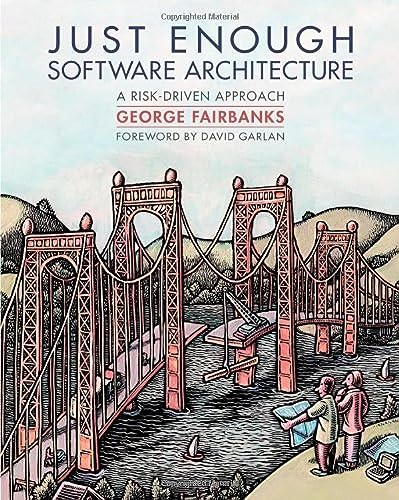Items related to Just Enough Software Architecture: A Risk-Driven Approach

Synopsis
This is a practical guide for software developers, and different than other software architecture books. Here's why:
It teaches risk-driven architecting. There is no need for meticulous designs when risks are small, nor any excuse for sloppy designs when risks threaten your success. This book describes a way to do just enough architecture. It avoids the one-size-fits-all process tar pit with advice on how to tune your design effort based on the risks you face.
It democratizes architecture. This book seeks to make architecture relevant to all software developers. Developers need to understand how to use constraints as guiderails that ensure desired outcomes, and how seemingly small changes can affect a system's properties.
It cultivates declarative knowledge. There is a difference between being able to hit a ball and knowing why you are able to hit it, what psychologists refer to as procedural knowledge versus declarative knowledge. This book will make you more aware of what you have been doing and provide names for the concepts.
It emphasizes the engineering. This book focuses on the technical parts of software development and what developers do to ensure the system works not job titles or processes. It shows you how to build models and analyze architectures so that you can make principled design tradeoffs. It describes the techniques software designers use to reason about medium to large sized problems and points out where you can learn specialized techniques in more detail.
It provides practical advice. Software design decisions influence the architecture and vice versa. The approach in this book embraces drill-down/pop-up behavior by describing models that have various levels of abstraction, from architecture to data structure design.
"synopsis" may belong to another edition of this title.
About the Author
Dr. George Fairbanks has been teaching software architecture and object-oriented design for over a decade for companies including Kinetium, Valtech, and Platinum Technology. In the Spring of 2008 he was the co-instructor for the graduate software architecture course at Carnegie Mellon University. He is currently the president of Rhino Research, a software architecture training and consulting company.
He holds a Ph.D. in Software Engineering from Carnegie Mellon University, advised by David Garlan and Bill Scherlis. His dissertation introduced design fragments, a new way to specify and assure the correct use of frameworks through static analysis. He has publications on frameworks and software architecture in selective academic conferences, including OOPSLA and ICSE.
He has written production code for telephone switches, plugins for the Eclipse IDE, and everything for his own web dot-com startup. He maintains a network of Linux servers in his spare time.
George has been a program committee member for the Working International Conference on Software Architecture (WICSA), the International Conference on Software Maintenance (ICSM), and the European Conference on Software Architecture (ECSA). He has been a referee for IEEE Transactions on Software Engineering (TSE) and IEEE Software.
"About this title" may belong to another edition of this title.
US$ 3.75 shipping within U.S.A.
Destination, rates & speedsBuy New
View this itemUS$ 33.77 shipping from United Kingdom to U.S.A.
Destination, rates & speedsSearch results for Just Enough Software Architecture: A Risk-Driven Approach
Just Enough Software Architecture: A Risk-Driven Approach
Seller: HPB-Red, Dallas, TX, U.S.A.
Hardcover. Condition: Good. Connecting readers with great books since 1972! Used textbooks may not include companion materials such as access codes, etc. May have some wear or writing/highlighting. We ship orders daily and Customer Service is our top priority! Seller Inventory # S_408706599
Quantity: 1 available
Just Enough Software Architecture: A Risk-Driven Approach
Seller: WorldofBooks, Goring-By-Sea, WS, United Kingdom
Paperback. Condition: Very Good. The book has been read, but is in excellent condition. Pages are intact and not marred by notes or highlighting. The spine remains undamaged. Seller Inventory # GOR008961542
Quantity: 1 available
Just Enough Software Architecture: A Risk-Driven Approach
Seller: WeBuyBooks, Rossendale, LANCS, United Kingdom
Condition: Very Good. Most items will be dispatched the same or the next working day. A copy that has been read, but is in excellent condition. Pages are intact and not marred by notes or highlighting. The spine remains undamaged. Seller Inventory # wbs4052563633
Quantity: 1 available
Just Enough Software Architecture: A Risk-Driven Approach
Seller: Goodwill Books, Hillsboro, OR, U.S.A.
Condition: Good. Signs of wear and consistent use. Seller Inventory # 3IIT4R004CUQ_ns
Quantity: 1 available
Just Enough Software Architecture: A Risk-Driven Approach
Seller: Revaluation Books, Exeter, United Kingdom
Hardcover. Condition: Brand New. 1st edition. 376 pages. 9.30x7.60x1.10 inches. In Stock. Seller Inventory # 0984618104
Quantity: 1 available

